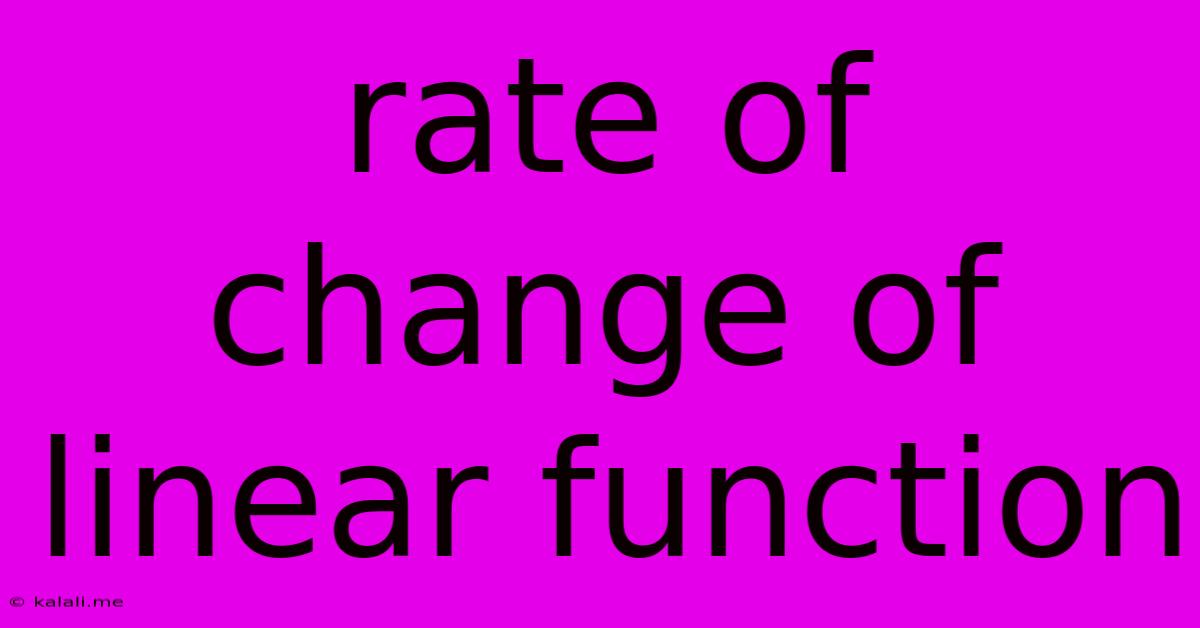Rate Of Change Of Linear Function
Kalali
May 10, 2025 · 3 min read

Table of Contents
Understanding the Rate of Change of a Linear Function
The rate of change is a fundamental concept in mathematics, particularly when dealing with functions. It describes how much one variable changes in relation to another. For linear functions, this rate of change is constant and incredibly straightforward to calculate. This article will explore what the rate of change is, how to calculate it for linear functions, and its significance in various applications.
What is a Linear Function?
A linear function is a function whose graph is a straight line. It can be represented in the form:
f(x) = mx + c
where:
xis the independent variable.f(x)(or y) is the dependent variable.mis the slope or rate of change.cis the y-intercept (the point where the line crosses the y-axis).
The Rate of Change: Slope Explained
The rate of change of a linear function is simply its slope (m). The slope represents the steepness of the line and indicates how much the dependent variable (y) changes for every unit change in the independent variable (x). A positive slope indicates a positive relationship (as x increases, y increases), while a negative slope indicates a negative relationship (as x increases, y decreases). A slope of zero means the line is horizontal, and there's no change in y as x changes.
Calculating the Rate of Change
There are several ways to calculate the slope (rate of change) of a linear function:
-
Using the formula: If the linear function is given in the form
f(x) = mx + c, the slope is simply the coefficient of x, which is m. -
Using two points: If you have two points on the line, (x₁, y₁) and (x₂, y₂), the slope can be calculated using the following formula:
m = (y₂ - y₁) / (x₂ - x₁)
This formula represents the change in y divided by the change in x.
Examples
Let's illustrate with a few examples:
-
f(x) = 3x + 2: The rate of change is 3. This means for every one-unit increase in x, y increases by 3 units.
-
f(x) = -2x + 5: The rate of change is -2. This indicates that for every one-unit increase in x, y decreases by 2 units.
-
Points (1, 4) and (3, 10): Using the two-point formula:
m = (10 - 4) / (3 - 1) = 6 / 2 = 3The rate of change is 3.
Significance and Applications
Understanding the rate of change is crucial in numerous real-world applications:
- Physics: Calculating speed (rate of change of distance over time), acceleration (rate of change of speed over time).
- Economics: Analyzing the relationship between price and quantity demanded, or cost and production.
- Finance: Determining the growth rate of investments.
- Engineering: Modeling the relationship between variables in various systems.
Conclusion
The rate of change of a linear function, represented by its slope, is a simple yet powerful concept. Its ease of calculation and clear interpretation make it a fundamental tool for understanding and modeling linear relationships in a wide range of fields. Mastering this concept provides a strong foundation for tackling more complex mathematical problems involving rates of change in non-linear functions.
Latest Posts
Latest Posts
-
How Many Cups Is 1 Pound Of Cheese
Jul 12, 2025
-
30 X 30 Is How Many Square Feet
Jul 12, 2025
-
How Much Does A Half Oz Weigh
Jul 12, 2025
-
Calories In An Omelette With 3 Eggs
Jul 12, 2025
-
How Do You Say Great Grandmother In Spanish
Jul 12, 2025
Related Post
Thank you for visiting our website which covers about Rate Of Change Of Linear Function . We hope the information provided has been useful to you. Feel free to contact us if you have any questions or need further assistance. See you next time and don't miss to bookmark.